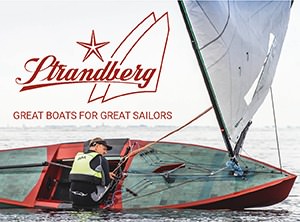You are here: okdia.org > technical > technical manual > windy weather
Technical Manual
Sailing In Windy Weather
by Julius Mach
Recently whilst sitting on the bottom of my hull inspecting the centre board my thoughts dwelt on why I had capsized. I was able to give the matter some considerable thought since it is useless trying to right an OK whilst the wind is in excess of forty knots. In any case, the wind and the tide were causing me to drift in the direction of the next mark, whilst my only opposition on this day - a Merlin Rocket was also drifting to the same mark but unfortunately for him he had already rounded it and had been going up the beat. If this state of affairs continued for another twenty minutes I reasoned I would actually overtake the Merlin.
However, back to the capsize. I had fallen in because in a wind strength exceeding twenty knots I had been attempting to race instead of my normal practice of concentrating on staying upright whilst sailing round a course. This latter strategy has served well in the past, producing respectable results at the nationals and many successes at club level. One or two people at the Lowestoft nationals were interested in learning that 'survival' sailing, so at the risk of boring the experts, I thought I might explain how I tackle the windy stuff and if anyone has any other ideas please write in and let the rest of us share in the secrets.
Downwind - Running
To reduce rolling I keep the centreboard about halfway down. Easing the kicker lets the boom ride up and clear the wavecrests. Catching the waves with the boom is a very common cause of a capsize. Having eased the kicker the boom needs to be sheeted in to prevent the top of the sail setting in front of the mast thus causing a capsize to windward. Sheeting the boom in further reduces the power generated by the rig as the effective area opposing the wind is reduced. The boat is then kept upright by steering into whichever way it is tending to fall. This is the same principle as riding a bicycle - if falling to the right steer to the right and vice-versa. If the boat starts to nosedive then bear away, but if it actually grinds to a halt and tries to stand on end, push the tiller away and sit out hard and pray. More often than not the boat will come up into the wind and stay upright. Bearing away when the boat tips to leeward or nosedives will not cause a gybe since until it comes level the boat will not actually bear away. However once the boat is flat stop trying to bear away or the boat really will bear away.
If you have difficulty trying to bear away onto a run then try bouncing on the side deck, as this often causes sufficient of a lurch to enable the boat to break away onto a run. Finally, a run is easier to sail the nearer a dead run it is.
The setting of the cunningham and outhaul are not relevant , and as sitting right at the back of the cockpit helps prevent nosediving and totally prevents me from reaching any control lines I do not bother with these controls.
Reaching
Easing the kicker lifts the boom out of the water and causes the sail to twist so that the top half of the sail (by height) can be emptied of wind whilst the bottom half remains full of wind. This reduces the tipping moment with relatively little loss of power. Steering to keep the boat flat as described above is then all that is necessary If the boat tilts and will not right by steering then ease the sheet until the boat rights itself and then sheet in again until the lower half of the sail is pulling.
Beating
To assist in keeping the boat flat I usually raise the centreboard up to as much as halfway. The keen eyed among you will notice that in very windy weather (force 6) I never need to adjust the centreboard. The traveller needs to be let out fully and the boom sheeted as tight as it will go. The mast bend induced by this will help flatten the sail. The clew or outhaul needs to be pulled as near the end of' the boom as it will go, this again flattens the sail. Finally the cunningham must be pulled down HARD. If you can't pull it down far enough get some extra purchase. I use four to one purchase on the cunningham and lines that don't cut my hands to shreds when I pull hard. The idea is to get the leech to invert at the top of the sail. This together with the mast bending sideways under the force of the wind should result in as little as just one third of the height of the sail being full of wind and the rest not doing anything at all. This is not possible if your sail is hopelessly blown out or your rig does not suit your weight.
When purchasing a new sail the sailmaker should be informed of your sailing weight so that he can cut the sail to invert and spill wind just as you become overpowered and so leave you with the maximum power you can just handle. This means the rig works for you. When buying secondhand try and buy from someone of about your weight.
Finally try and find a smooth path up the beat. Try and spot the lower parts of waves and steer to sail through them, this will mean you are slowed less. When tacking wait for a calmer patch of water and if you land in irons immediately reverse the rudder as you sail backwards until you have born away sufficiently to sheet in and accelerate forwards.
Weight Jackets
I never wear one. My sailing weight is 10-11 stone and I use a Boyce mast. I believe that weight jackets restrict the rapid movements that are required on reaches and beats in windy weather. Although the jackets are buoyant in the water the extra effort required to get back into a capsized boat often leaves a helm not at the peak of fitness in an exhausted state.
Note
A guide to survival, not to sailing very fast! Nevertheless it offers some good advice to club sailors, particularly those lightweights around 70kg.
Weight jackets are now outlawed by the 'Racing Rules of Sailing'.










